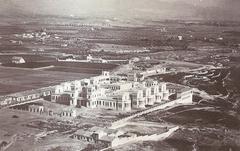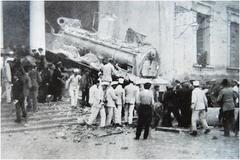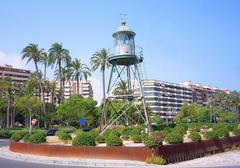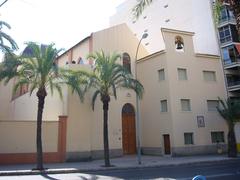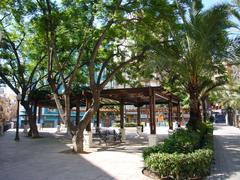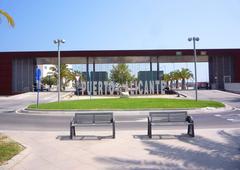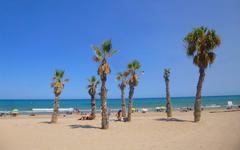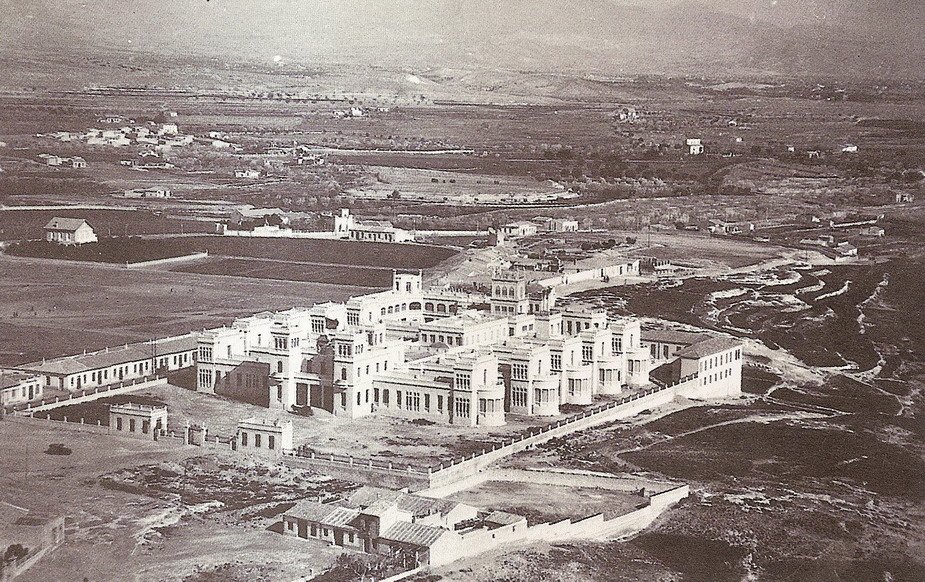
Hospital Provincial de Alicante Visiting Guide: Tickets, Hours, and Tips
Date: 14/06/2025
Introduction: Hospital Provincial de Alicante & Its Historical Significance
Visiting Hospital Provincial de Alicante is not only about accessing medical care; it is also a gateway to discovering a significant chapter of Alicante’s history and cultural landscape. Now officially known as Hospital General Universitario Dr. Balmis, this hospital is located in the lively Altozano neighborhood, close to both residential areas and several of Alicante’s most notable historical sites. Whether you are visiting as a patient, supporting a loved one, or exploring the city’s unique blend of healthcare and heritage, this comprehensive guide covers everything you need—location, accessibility, visitor information, and nearby attractions (Alicante Travel Guide).
The hospital’s roots stretch back to the 19th century, when it was first known as the Hospital de San Juan de Dios. It has played a crucial role through times of epidemics, the Spanish Civil War, and the city’s rapid urban growth. After serving generations of Alicante’s residents, the original hospital building was transformed into the Museo Arqueológico Provincial de Alicante (MARQ), symbolizing the city’s dedication to preserving its heritage and fostering cultural education (Alicantepedia; Alicante About).
The hospital’s location allows visitors to easily combine healthcare needs with cultural exploration, as it is situated near significant landmarks like Santa Bárbara Castle, the Explanada de España, and MARQ (alicante-tourism.com; MARQ). This guide also provides practical details on transportation, accessibility for all visitors, hospital amenities, and safety measures, as well as insights into the area’s vibrant community life and events.
Contents Overview
- Introduction
- Location of Hospital Provincial de Alicante
- Accessibility
- Public Transport
- Taxi
- Private Car
- Bicycle and Pedestrian Access
- Accessibility for People with Disabilities
- Visitor Experience
- Navigating the Hospital
- Visiting Hours and Admission
- Language and Communication
- Emergency Services
- Pharmacies and Nearby Services
- Safety and Security
- Visitor Amenities
- Proximity to Alicante Historical Sites
- The Hospital’s Historical and Cultural Significance
- Visiting Santa Bárbara Castle
- History and Significance
- Visiting Hours & Admission
- Accessibility and Getting There
- Events and Exhibitions
- Visitor Tips
- Frequently Asked Questions (FAQs)
- Conclusion
Location of Hospital Provincial de Alicante
Hospital Provincial de Alicante (Hospital General Universitario Dr. Balmis) is located in northern Alicante, in the Altozano neighborhood. Its address is C/ Pintor Baeza, s/n, 03010 Alicante (Alicante Travel Guide, p. 14). The hospital is close to key sites such as Estadio José Rico Pérez, MARQ, and Parque Lo Morant (Mapcarta), and is about 2.5 km from the city center. Its central position ensures easy access for locals and visitors alike, and places it within reach of the city’s beaches, historic quarters, and major urban amenities (IdealSpain).
Accessibility
Public Transport
Alicante’s urban bus network (Subús) connects the hospital with the rest of the city:
- Line 06: City center to Altozano
- Line 09: Central market to hospital area
- Line 13: Alicante-Terminal train station to hospital vicinity
Buses run frequently and stops are within a short walk of the hospital entrance (IdealSpain).
Taxi
Taxis are widely available:
- Area Taxi: 965 91 05 91
- Euro Taxi (accessible): 965 91 05 74
A trip from the city center typically takes 10–15 minutes (Alicante Travel Guide, p. 13).
Private Car
Access is via Avenida de Denia and Avenida de Alcoy. On-site parking is available, including spaces for disabled visitors, though it may fill during peak times.
Bicycle and Pedestrian Access
Bike lanes and pedestrian-friendly routes connect the hospital with nearby neighborhoods. The area is suitable for wheelchairs and mobility aids (IdealSpain).
Accessibility for People with Disabilities
The hospital features wheelchair-accessible entrances, elevators, adapted restrooms, and reserved parking. Public transport and Euro Taxis also offer accessible options.
Visitor Experience
Navigating the Hospital
Wayfinding signage in Spanish and English helps visitors locate departments. Reception staff are available for assistance, and translation services can be arranged if needed.
Visiting Hours and Admission
- General visiting hours: 10:00–20:00 (may vary by department or during health emergencies)
- Emergencies: 24/7
- Admission: No ticket required; this is a public medical facility
Check the hospital’s official site or call ahead for real-time updates.
Language and Communication
Spanish is the main language, but many staff speak English, especially in reception and emergency areas. Translation services are available upon request.
Emergency Services
The emergency department operates round-the-clock. In a medical emergency, dial 112 (Alicante Travel Guide, p. 14).
Pharmacies and Nearby Services
Numerous pharmacies are located in and around the hospital. Alicante Airport also has a pharmacy in the arrivals area (Tel: 966 91 94 19) (Alicante Travel Guide, p. 14). Cafes, restaurants, and shops are within walking distance.
Safety and Security
Alicante is considered safe. The area is patrolled by police, and hospital security includes staff and CCTV cameras. Emergency contacts:
- Local Police: 092
- National Police: 091
- Guardia Civil: 062
- Emergencies: 112 (Alicante Travel Guide, p. 14)
Visitor Amenities
Facilities include cafeterias, vending machines, waiting lounges, and limited Wi-Fi. Hotels and guesthouses nearby provide accommodation.
Proximity to Alicante Historical Sites
The hospital’s location makes it easy to combine visits with cultural exploration:
- Estadio José Rico Pérez: Football stadium
- MARQ: Archaeological Museum (MARQ)
- Parque Lo Morant: Urban park (Mapcarta)
The Hospital’s Historical and Cultural Significance
From Healthcare to Cultural Beacon
Founded as Hospital de San Juan de Dios in the 19th century, this hospital played a central role during public health crises and the Spanish Civil War (Alicantepedia). Managed by the San Juan de Dios religious order, it also contributed to local cultural life with a theater and community initiatives.
As Alicante grew, newer hospitals took over its role, and the original building was closed in 1991. In 2000, it was reborn as the Museo Arqueológico Provincial de Alicante (MARQ), reflecting Alicante’s commitment to preserving its heritage (Alicante About; WhichMuseum).
Architectural Importance
Designed by Juan Vidal and Manuel Bernal Gallego, the 1931 building is a landmark of regional hospital architecture with a focus on hygiene and accessibility (Alicantepedia).
MARQ Today
MARQ displays over 81,000 artifacts, offering interactive exhibits and community outreach programs (Alicante About). Its transformation from hospital to museum stands as a testament to Alicante’s civic pride and adaptability.
Visiting Santa Bárbara Castle
History and Significance
Santa Bárbara Castle dominates Alicante from atop Mount Benacantil. Built in the 9th century during Muslim rule, it has witnessed centuries of military, political, and social change (alicante-tourism.com). The castle’s architecture features Moorish and Christian influences, and today it hosts exhibitions and events celebrating local history.
Visiting Hours & Admission
- Summer (April–September): 10:00–20:00
- Winter (October–March): 10:00–18:00
- Admission: Free; guided tours and special exhibitions may require a ticket (alicante.es)
Accessibility and Getting There
Reach the castle by foot (steep but scenic), public bus (lines 7 and C6), taxi, or the public elevator from Postiguet Beach—a great option for families and visitors with reduced mobility.
Events and Special Exhibitions
Santa Bárbara Castle hosts cultural events year-round, such as medieval reenactments, concerts, and temporary exhibitions. Events are updated regularly on the official tourism site.
Visitor Tips
- Arrive early or in late afternoon to avoid crowds and heat.
- Wear comfortable footwear.
- Bring a camera for panoramic city views.
- Check for events and opening hours before visiting.
- Combine your visit with nearby attractions like Explanada de España or Old Town.
Frequently Asked Questions (FAQs)
What are the visiting hours at Hospital Provincial de Alicante?
Generally 10:00–20:00, but check with the hospital for department-specific or seasonal changes. Emergency services operate 24/7.
Is there an entrance fee for the hospital?
No, hospital access does not require a ticket.
Is the hospital accessible for people with disabilities?
Yes, the hospital and the MARQ museum both offer full accessibility.
Are guided tours available at the hospital?
As a medical facility, tours are not offered. However, guided tours are available at MARQ and Santa Bárbara Castle.
How do I get to the hospital from Alicante Airport?
Take a taxi, bus, or train to the city center, then use bus lines 06, 09, or 13, or a taxi to reach the hospital.
Are there pharmacies nearby?
Yes, multiple pharmacies are in the area, including one at Alicante Airport (Alicante Travel Guide, p. 14).
Contact Information
- Address: C/ Pintor Baeza, s/n, 03010 Alicante, Spain
- Telephone: 965 93 83 00 (Alicante Travel Guide, p. 14)
Check the official hospital site for updates.
Conclusion
Hospital Provincial de Alicante is a vital healthcare institution, seamlessly integrated into Alicante’s historic and urban landscape. Its accessibility, comprehensive services, and proximity to major cultural landmarks—including the MARQ museum and Santa Bárbara Castle—make it a unique point where tradition and modernity converge. Whether you are seeking medical care or a deeper understanding of Alicante’s heritage, you’ll find practical information and cultural inspiration in this guide.
For additional resources, travel planning, and interactive maps, download the Audiala app and follow our social media channels.
Sources
- Alicante Travel Guide, 2025, Various Authors
- Alicantepedia - Hospital de San Juan de Dios, 2024, Alicantepedia
- Alicante About - MARQ Archaeological Museum, 2024, Alicante About
- WhichMuseum - Museo Arqueológico Provincial de Alicante, 2024, WhichMuseum
- Alicante Tourism - Santa Bárbara Castle, 2024, Alicante Tourism
- Alicante City Official Tourism Portal, 2024, Alicante Turismo
- Generalitat Valenciana - Hospital Provincial De Alicante Department Info, 2024, GVA.es
